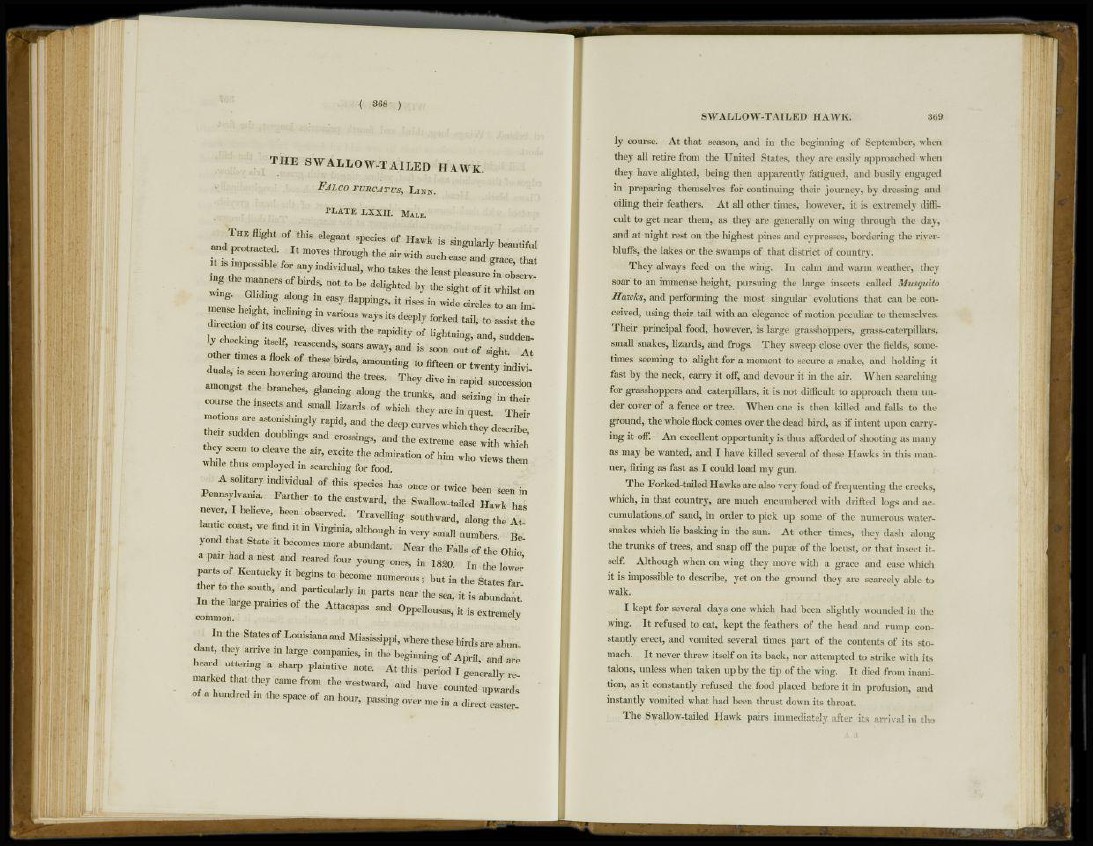
T H E S W A L L O W - T A I L E D H A W K.
FALCO FURCATUS, LINN.
P L A T E L X X I I . MALE.
THE flight of this elegant species of Hawk is singularly beautiful
and protracted. It moves through the air with such ease and grace, that
it is impossible for any individual, who takes the least pleasure in observing
the manners of birds, not to be delighted by the sight of it whilst on
wing. Gliding along in easy flappings, it rises in wide circles to an immense
height, inclining in various ways its deeply forked tail, to assist the
direction of its course, dives with the rapidity of lightning, and, suddenly
checking itself, reascends, soars away, and is soon out of sight. At
other times a flock of these birds, amounting to fifteen or twenty individuals,
is seen hovering around the trees. They dive in rapid succession
amongst the branches, glancing along the trunks, and seizing in their
course the insects and small lizards of which they are in quest. Their
motions are astonishingly rapid, and the deep curves which they describe,
their sudden doublings and crossings, and the extreme ease with which
they seem to cleave the air, excite the admiration of him who views them
while thus employed in searching for food.
A solitary individual of this species has once or twice been seen in
Pennsylvania. Farther to the eastward, the Swallow-tailed Hawk has
never, I believe, been observed. Travelling southward, along the Atlantic
coast, we find it in Virginia, although in very small numbers. Beyond
that State it becomes more abundant. Near the Falls of the Ohio,
a pair had a nest and reared four young ones, in 1820. In the lower
parts of Kentucky it begins to become numerous; but in the States farther
to the south, and particularly in parts near the sea, it is abundant.
In the large prairies of the Attacapas and Oppellousas, it is extremely
common.
In the States of Louisiana and Mississippi, where these birds are abundant,
they arrive in large companies, in the beginning of April, and are
heard uttering a sharp plaintive note. At this period I generally remarked
that they came from the westward, and have counted upwards
of a hundred in the space of an hour, passing over me in a direct easter-
S WALL O W-T AIL ED HAWK. 369
ly course. At that season, and in the beginning of September, when
they all retire from the United States, they are easily approached when
they have alighted, being then apparently fatigued, and busily engaged
in preparing themselves for continuing their journey, by dressing and
oiling their feathers. At all other times, however, it is extremely difficult
to get near them, as they are generally on wing through the day,
and at night rest on the highest pines and cypresses, bordering the riverbluffs,
the lakes or the swamps of that district of country.
They always feed on the wing. In calm and warm weather, they
soar to an immense height, pursuing the large insects called Musguito
Hawks, and performing the most singular evolutions that can be conceived,
using their tail with an elegance of motion peculiar to themselves.
Their principal food, however, is large grasshoppers, grass-caterpillars,
small snakes, lizards, and frogs. They sweep close over the fields, sometimes
seeming to alight for a moment to secure a snake, and holding it
fast by the neck, carry it off, and devour it in the air. When searching
for grasshoppers and catei-pillars, it is not difficult to approach them under
cover of a fence or tree. When one is then killed and falls to the
ground, the whole flock conies over the dead bird, as if intent upon carrying
it off. An excellent opportunity is thus afforded of shooting as many
as may be wanted, and I have killed several of these Hawks in this manner,
firing as fast as I could load my gun.
The Forked-tailed Hawks are also very fond of frequenting the creeks,
which, in that country, are much encumbered with drifted logs and accumulations
of sand, in order to pick up some of the numerous watersnakes
which lie basking in the sun. At other times, they dash along
the trunks of trees, and snap off the pupae of the locust, or that insect itself.
Although when on wing they move with a grace and ease which
it is impossible to describe, yet on the ground they are scarcely able to
walk.
I kept for several days one which had been slightly wounded in the
wing. It refused to eat, kept the feathers of the head and rump constantly
erect, and vomited several times part of the contents of its stomach.
It never threw itself on its back, nor attempted to strike with its
talons, unless when taken up by the tip of the wing. It died from inanition,
as it constantly refused the food placed before it in profusion, and
instantly vomited what had been thrust down its throat.
The Swallow-tailed Hawk pairs immediately after its arrival in the